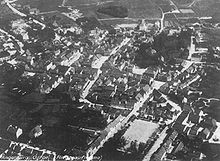Węgorzewo
Węgorzewo | ||
|---|---|---|
| ||
|
Car plates NWE | | |
| National roads | ||
| Voivodeship roads | ||
| Website | http://www.wegorzewo.pl | |
Węgorzewo
Etymology
The town's names in different languages are derived from local names for
History
Beginnings
The town was first mentioned in a 1335 chronicle as Angirburg, or "eel castle", a settlement of the
Polish suzerainty

In 1454, the region was incorporated by King
Being situated in
Kingdom of Prussia
Angerburg became part of the
King Stanisław Leszczyński of Poland stopped in the castle in March and May 1736.[5]
Angerburg was included in the Prussian province of
The canalization of the Angerapp and the expansion of the harbor in 1856 allowed business to expand, and the garrison left the town in 1858. The district court and the office of the public prosecutor moved from Angerburg to Lyck (Ełk) after the Kreistag, or district parliament, hindered the connection of the town to developing road network and railways. Four annual fairs and two weekly markets were held in the town in the late 19th century.[1] Angerburg was first connected to the railroad network in 1898, allowing it to develop into a trade center. The town became especially known for its Behindertenanstalt Bethesda, an institute for those with mental retardation.
World Wars

Angerburg became a garrison town again after the outbreak of World War I (1914–18), when it had a population of 5,800 inhabitants. The German-Russian military cemetery Jägerhöhe was located nearby. The war did not impact the town greatly, and Angerburg grew through new housing developments afterwards. Angerburg also began to develop through tourism after the opening of the Angerapp to regular navigation. At the beginning of the Third Reich, the town had a population of 7,700 which profited from a local cavalry regiment. Through incorporation of neighboring communities, Angerburg expanded to include 10,922 inhabitants in 1939.
Like the rest of East Prussia, Angerburg was initially only indirectly affected by World War II (1939–45), such as casualties of war and supply shortages. This situation changed as the eastern front grew near during the winter of 1944-45. Unlike the neighboring town of Gołdap to the east, Angerburg was not involved in fighting, but was given up by the Wehrmacht as the Soviet Red Army advanced. After the Red Army reached Elbing (Elbląg) and cut off East Prussia from the rest of Germany, the citizens of Angerburg were forced to evacuate the province by traveling across the Vistula Lagoon or to Pillau. The Red Army reached Angerburg on January 25, 1945 and destroyed much of the town; only a few buildings remained of the old town center.
Modern Poland
Under the terms of the post-war Potsdam Conference, the town became again part of Poland and was renamed Węgorzewo.
Węgorzewo initially suffered economically after the fall of the Iron Curtain and the Revolutions of 1989, but has become a popular tourist site in the Masurian Lake District. The town is famous for the music festivals which take place in summertime, including a rock festival, a sailors' song festival, and a poetic song festival.
Notable residents
- Albrycht Zaborowski (1638–1711), Polish emigrant, one of the pioneers of European colonization within the area of present-day New Jersey
- Georg Andreas Helwing (1666–1748), botanist
- Siegfried Heinrich Aronhold (1819–1884), mathematician
- Rodolphe Radau (1835–1911), astronomer
- Kurt Haehling (1893–1983), Wehrmacht general
- Martin Sommerfeld (1894–1939), Jewish emigre to the U.S. and university lecturer
- Herbert Jankuhn (1905–1990), archaeologist
- Klaus Ewerth (1907–1943), Kriegsmarine officer
- Andreas Hillgruber (1925–1989), historian
- Bożena Ksiąźek (born 1963), Polish sprint canoer
- Mariusz Duda (born 1975), Polish musician
- Patryk Kun (born 1995), Polish footballer
International relations

Węgorzewo is a member of Cittaslow.
Twin towns — Sister cities
Węgorzewo is
|
References
- ^ a b c Słownik geograficzny Królestwa Polskiego i innych krajów słowiańskich, Tom XIII (in Polish). Warszawa. 1893. p. 255.
{{cite book}}: CS1 maint: location missing publisher (link) - ^ Górski, Karol (1949). Związek Pruski i poddanie się Prus Polsce: zbiór tekstów źródłowych (in Polish). Poznań: Instytut Zachodni. p. 54.
- ^ Górski, pp. 96–97, 214–215
- ISBN 83-7383-067-7.
- ^ a b c Pod Jelonkiem, numer 1/2006, p. 7 (in Polish)
- ^ von Haxthausen, August (1839). Die ländliche verfassung in den einzelnen provinzen der Preussischen Monarchie (in German). Königsberg: Gebrüder Borntraeger Verlagsbuchhandlung. pp. 78–81.
- ^ Jasiński, Grzegorz (2009). "Statystyki językowe powiatów mazurskich z pierwszej połowy XIX wieku (do 1862 roku)" (PDF). Komunikaty Mazursko-Warmińskie (in Polish). 1: 97–130 – via BazHum.
- ^ Belzyt, Leszek (1996). "Zur Frage des nationalen Bewußtseins der Masuren im 19. und 20. Jahrhundert (auf der Basis statistischer Angaben)". Zeitschrift für Ostmitteleuropa-Forschung (in German). Bd. 45, Nr. 1: 35–71 – via zfo-online.
- ^ Groniewska, Barbara (1960). "Rola Prus Wschodnich w powstaniu styczniowym". Komunikaty Mazursko-Warmińskie (in Polish). No. 1. p. 22.
- ^ Groniewska, p. 40
External links
- Municipal website
- Węgorzewo rock music festival (in Polish)




